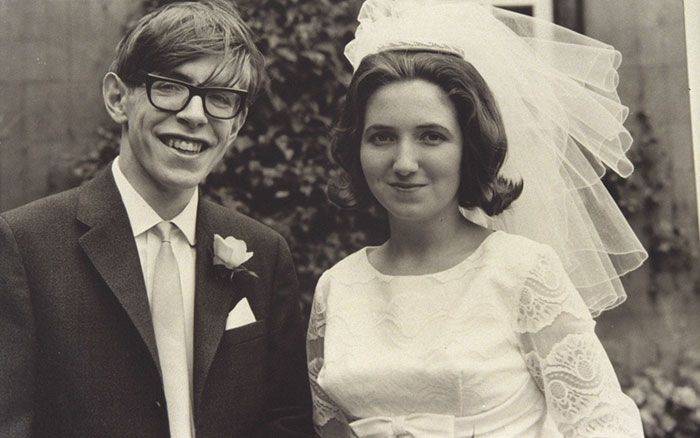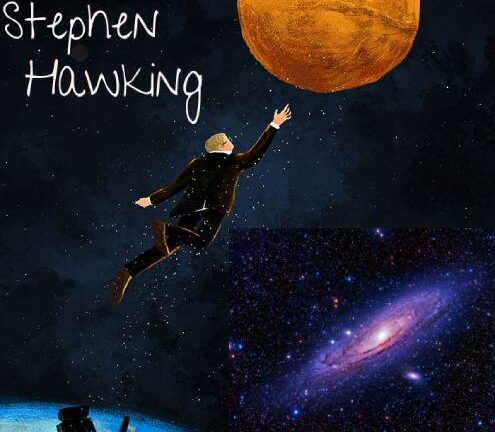Stephen Hawking was born on January 8, 1942, in Oxford, England, and was the son of Frank and Isobel Hawking. His parents both went to Oxford University, and his father was a medical researcher. As a child, Stephen loved math and science. In school, he earned the nickname “Einstein” for his intelligence. He wanted to study math at university, but since Oxford didn’t offer a math degree, he studied physics and chemistry instead. Stephen found college studies easy and enjoyed activities like rowing and listening to classical music. After graduating, he moved to Cambridge to pursue his PhD.
Diagnosed with ALS
Stephen Hawking was diagnosed with ALS (amyotrophic lateral sclerosis) at the age of 21, a disease that slowly robbed him of his muscle control. As the disease progressed, Stephen lost the ability to move most parts of his body, including his vocal cords. It was a devastating blow to someone who loved to communicate his ideas.
But Stephen Hawking wasn’t the type of person to let anything stand in his way. Instead of giving up, he turned to technology to help him talk to the world.
Overcoming Challenges
At first, Stephen was deeply upset by the diagnosis. However, he found hope through his work and his love for Jane Wilde, whom he later married. He worked harder than ever to complete his PhD and live a meaningful life. Although ALS left him in a wheelchair and unable to speak.
The Speech Synthesizer
In the 1980s, Hawking was introduced to a speech-generating device that would change his life. The first device he used was a hand-held system called the “Equalizer,” which allowed him to select words by moving his cheek muscles. This was the start of his new way of communicating.
Computer-Based Speech Synthesizer
However, as his condition worsened, even the cheek muscle control became difficult. In the 1990s, a new system was developed for him: a computer-based speech synthesizer that was controlled by his cheek muscles. This system was connected to a computer, which would allow Stephen to type out his words, which would then be converted into speech by a synthesizer.
The Iconic Voice
The voice that Stephen Hawking used became instantly recognizable. The synthetic voice, though not his own, was a crucial part of his identity. Many people around the world came to associate that robotic voice with the genius behind it, and it became as iconic as his scientific theories.
The speech synthesizer used by Stephen Hawking wasn’t just a tool—it became a symbol of his unwavering spirit. Even though it wasn’t his natural voice, it allowed him to continue communicating with the world, sharing his ideas, his humor, and his groundbreaking discoveries.
The Technology Behind the Voice
The voice that Stephen Hawking used was a product of a company called “Speech Plus.” This was one of the first speech synthesis systems for people with disabilities. Stephen’s voice was created from a set of pre-recorded words that were pieced together by the computer, giving it a very distinctive sound.
Interestingly, Stephen could have chosen a different voice, but he stuck with the original one, even as new, more advanced voices became available. Why? Because that voice was familiar to him. It was the voice that he had used for so many years, and changing it would have felt like losing part of his identity.
How Did He Control the Computer?
So, how did Stephen control the computer with just a small muscle movement? The answer lies in a small infrared sensor that he had attached to his cheek. This sensor detected the tiny movement of his cheek muscle, allowing him to select letters and words on the screen. It was an amazing example of how technology can help someone who has been given a physical challenge to continue living a rich and full life.
As the years went by, Stephen’s system was updated, and the technology improved. But no matter how much the devices changed, the heart of his communication remained the same: a deep desire to share his thoughts with the world, no matter what.
Stephen Hawking’s Voice
Stephen Hawking’s voice wasn’t just a tool for communication. It was a symbol of his strength, determination, and refusal to give up. His voice inspired millions of people, proving that no matter how challenging life may get, there’s always a way to keep moving forward.
Even after Stephen’s passing in 2018, his voice remains a part of his legacy, reminding us that the power of the human spirit can overcome any obstacle and that the quest for knowledge and understanding can never be silenced.

Major Scientific Contributions
Mini Black Holes And the Big Bang
Stephen Hawking’s work focused on two major areas: black holes and the origins of the universe. In 1971, Stephen suggested that small “mini black holes” were created just after the Big Bang. He also explored the early stages of the universe, contributing to our understanding of how it began.
Quantum Mechanics and General Relativity
Hawking worked to unite the two main theories of physics—quantum mechanics and general relativity. His work in this area reshaped the way scientists think about the cosmos.
Hawking Radiation
In the 1970s, Hawking revolutionized physics by predicting that black holes emit radiation, now known as Hawking Radiation. He proposed that while some particles near a black hole’s event horizon escape as radiation, others remain trapped. Over time, this radiation causes black holes to evaporate—a theory that challenged Einstein’s views on gravity and proved correct.
- Singularities and Big Bang Theory – Applied Einstein’s theories to explain the universe’s origins.
- Black Hole Mechanics – Developed laws showing black holes emit radiation and are “hot.”
- Cosmic Inflation Theory – Calculated quantum fluctuations that lead to galaxy formation.
- Wave Function of the Universe – Suggested time didn’t exist before the Big Bang.
- Top-Down Cosmology – Proposed the universe began from multiple possible initial states.
His research connected quantum mechanics and relativity, reshaping how we understand black holes and the universe.
Famous Books and Public Impact
Stephen Hawking wasn’t just known for his scientific work; he also wrote several books aimed at making complex ideas accessible to everyone. His most famous book, A Brief History of Time (1988), became a bestseller and introduced millions of readers to the mysteries of the universe, black holes, and time. Other books he wrote include:
- A Brief History of Time (1988), which became a bestseller.
- The Universe in a Nutshell (2001).
- The Grand Design (2010), co-written with Leonard Mlodinow.
Through his books, Stephen made science easy to understand and sparked curiosity in people all over the world.
Awards and Honors
Stephen Hawking’s work didn’t go unnoticed. He received numerous prestigious awards throughout his life:
- Royal Society Membership (1974): He became one of the youngest members of this esteemed scientific society.
- Lucasian Professor of Mathematics (1979): This is one of the most prestigious academic positions, once held by Isaac Newton.
- Copley Medal (2006) and Presidential Medal of Freedom (2009): Among other awards, these recognized his immense contributions to science.
Stephen Hawking Timeline
Occupation: Scientist and Astrophysicist
Born: January 8, 1942, Oxford, United Kingdom
Died: March 14, 2018, Cambridge, United Kingdom
Best Known For: the book “A Brief History of Time” & Hawking Radiation
Interesting Facts About Stephen Hawking
- He was born 300 years after Galileo’s death.
- He appeared on TV shows like The Simpsons and The Big Bang Theory.
- His book A Brief History of Time includes only one equation: Einstein’s famous E=mc².
- Stephen co-wrote children’s books with his daughter, Lucy, including George’s Cosmic Treasure Hunt.
- He received the Presidential Medal of Freedom in 2009
Stephen Hawking a Symbol Of Resilience and Purpose
Life is full of unexpected moments that change the way we view ourselves and the world. One such profound insight comes from Stephen Hawking’s final book, Brief Answers to the Big Questions. In it, Hawking inspires us to concentrate on our abilities and possibilities instead of fixating on our limitations.
In a special excerpt, when asked for advice to people with disabilities, Hawking said:
“Concentrate on things your disability doesn’t prevent you from doing well, and don’t regret things it interferes with. Don’t be disabled in spirit, as well as physically.”
This message is universal. We all have limitations, but these don’t define us. Instead, they remind us to focus on our strengths and excel in what truly matters. The world often pressures us to do it all, but as Hawking and Einstein both suggest, our value lies in pursuing what we’re naturally good at.
Hawking’s journey is proof of this. Despite being diagnosed with ALS in his early 20s and given only months to live, he transformed science and inspired millions. His resilience and curiosity left an indelible mark on humanity.
Hawking’s parting advice resonates deeply:
“Look up at the stars, not down at your feet. Be curious. However difficult life may seem, there is always something you can do and succeed at. It matters that you don’t just give up.”
His legacy reminds us to embrace our abilities, nurture them, and maximize our unique potential.
Legacy
Despite being in a wheelchair and unable to speak without a computer, Hawking inspired millions with his determination and brilliance. He passed away on March 14, 2018, at the age of 76, in Cambridge, leaving behind a legacy of incredible scientific discoveries and inspiring countless people worldwide.

